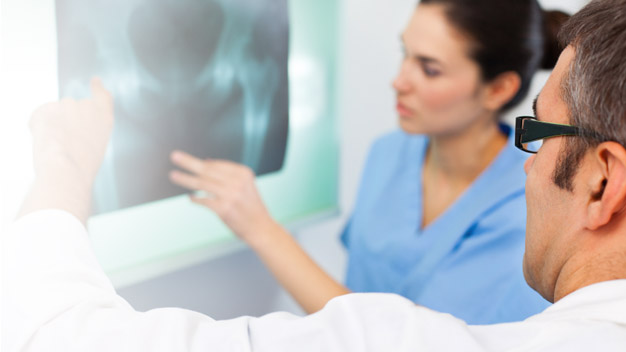In this section
In This Section
Careers information
Radiographers work in teams that consist of:
Support staff that carry out a range of varied roles supporting the team. The roles of support staff are locally determined. This means that the role is flexible to meet the needs of local patients and carers. An example is the role of chaperone; caring for and preparing patients and carers prior to and following an examination or treatment.
Assistant practitioners are non-registered staff trained to high standards to perform a specific range of clinical imaging examinations or treatment procedures. Assistant practitioners’ work is delegated under the supervision of a registered radiographer or radiologist. Assistant practitioners underpin and enable what is referred to as a four-tier structure in radiography. The four-tier structure refers to different roles within the team: assistant practitioner; radiographer practitioner; advanced practitioner radiographer; consultant radiographer.
Radiographers are regulated professionals with the Health and Care Professions Council (HCPC). They are entitled to hold one of the protected titles Radiographer, Diagnostic Radiographer or Therapeutic Radiographer. Radiographers undertake a broad portfolio of either diagnostic examinations or radiotherapy procedures. They work in partnership with team members, patients and carers to deliver care that may include screening, diagnosis, treatment or health monitoring for patients. To register, radiographers must hold a relevant BSc(hons) or MSc qualification. To maintain registration with the HCPC Radiographers must undertake and keep a record of their continued professional development. In addition to HCPC standards, radiographers work to the standards of the Society of Radiographers code of professional conduct. The code includes expectations that radiographers act in accordance with values of respect, empowerment, empathy, trustworthiness, integrity and justice. Radiographers must always act with compassion: caring for patients is at the heart of what radiographers, assistant practitioners and support staff do.
Diagnostic radiographers work in areas that include X-ray, Ultrasound, Fluoroscopy, Computerised Tomography (CT), Magnetic Resonance Imaging (MRI), Nuclear Medicine, Angiography and Mammography.
Therapeutic radiographers are responsible for the planning and delivery of accurate radiotherapy treatments using a wide range of technical equipment. Accuracy is critical, for example, the aim of treatment may be to treat a tumour and destroy diseased tissue while minimising the amount of radiation exposure to surrounding healthy tissue.
Together both diagnostic and therapeutic radiography professionals provide essential services every year to millions of people.
Post qualification, radiographers follow career paths according to a combination of their personal interests and the needs of healthcare services and patients. Promotion opportunities are excellent, with a grading structure that sees the radiographer's salary increase as s/he moves along the career pathway. British radiographers are recognised as receiving excellent training with innovative career paths. The Society and College of Radiographers supports the extension of the scope of practice of members where adequate education, training, and audit of practice provide safe and effective services to meet local patient needs.
Advanced practitioner and consultant radiographers increase responsibility in their job roles respectively to a point where the core domains of consultant work are: 1) expert clinical practice; 2) professional leadership and consultancy; 3) education, training & development, practice & service development; 4) research & evaluation.
Interested in joining a team as a radiographer? View directory of courses.
Would you like to arrange a visit to a department to help with your decision? View an A-Z list of all NHS Trusts, or ask your local university admissions tutor about open days.
